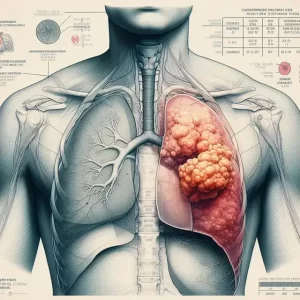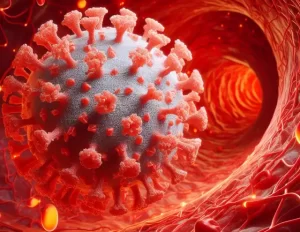12% of the Population Drives Half of U.S. Beef Consumption
- Brief Intermittent Exercise Reduces Heart Disease and Death Risk
- Personalized Lung Tumor Chips Assess PD-1 Therapy Response
- Study Shows Prior Infection Offers Strong Immunity to Original COVID-19 Strain
- Chinese Food Products Dominate Korean Tables Amid Safety Concerns
- Early Detection of Hypopharyngeal Cancer Possible with Saliva Diagnosis
- EB Virus Could Be Infected by Kiss: A Hidden Threat Linked to Cancer
12% of the Population Consumes Half of the U.S. Beef
- AstraZeneca Admits for the First Time that its COVID Vaccine Has Blood Clot Side Effects
- Was COVID virus leaked from the Chinese WIV lab?
- HIV Cure Research: New Study Links Viral DNA Levels to Spontaneous Control
- FDA has mandated a top-level black box warning for all marketed CAR-T therapies
- Can people with high blood pressure eat peanuts?
- What is the difference between dopamine and dobutamine?
- How long can the patient live after heart stent surgery?
12% of the Population Drives Half of U.S. Beef Consumption
One of the major driving factors behind the climate crisis is food production, accounting for one-third of global greenhouse gas emissions, with meat, particularly beef, at the forefront.
The United States is the largest consumer of beef in the world, but according to recent research, only a small portion of the population is responsible for this consumption.
A recent study has revealed that in the United States, a mere 12% of the population is responsible for consuming half of the country’s total beef consumption.
The author of the research report, Diego Rose, a professor of nutrition and director at Tulane University, stated, “It is possible that some of the 12% of people are not aware of the impact of beef on their health or the environment. The concerning question is, are you eating more than you should under normal circumstances?”
The study indicates that beef production goes hand in hand with deforestation to create pastures for cattle, resulting in global carbon emissions exceeding 4.2 billion metric tons. The impact of consuming beef is ten times that of chicken and over fifty times that of legumes. Numerous health studies have shown that red meat increases the risk of heart disease.

So, who are these 12% of people consuming this beef?
Men and individuals aged 50 to 65 are more likely to be labeled as “disproportionate beef consumers” by researchers. They are defined as those who consume over four ounces of beef per day, roughly equivalent to more than one hamburger, based on a recommended daily intake of 2,200 calories. This study analyzed snapshots of the daily diets of over ten thousand American adults over a four-year period.
Compared to other racial and ethnic groups like Black and Asian Americans, White Americans are more likely to consume larger quantities of beef. Older individuals, college graduates, and those who have consulted the United States Department of Agriculture’s (USDA) online nutrition program “MyPlate” are less likely to consume excessive amounts of beef.
The USDA recommends that the intake of all meat, poultry, and egg products should not exceed four ounces (113 grams). The study shows that, on average, teenage boys are consuming more meat, poultry, and egg products than these guidelines recommend, with an even greater disparity for adult males.
Experts point out that the high consumption of beef by men and boys has deep historical and cultural reasons. Joshua Specht, the author of “Red Meat Republic,” says, “There’s a connection between meat consumption and masculinity. Historically, being a successful man in the United States meant eating beef.”
With the expansion of the United States to the west and the clearing of indigenous lands and wild game, beef was introduced to North America for the first time. By the late 19th century, as immigrants from Europe arrived (where meat consumption was reserved for special occasions), vast ranches and industrial beef production made this rare delicacy more accessible. Subsidies for beef production by the federal government made beef even cheaper and more readily available.
Nowadays, there is growing discussion about the harm of meat consumption to the climate, and Republicans have even politicized meat consumption. Some have falsely claimed that Joe Biden would “ban” hamburgers.
Specht notes that meat is now a part of the “American identity.” “Meat, apple pie, football, having a pickup truck, these have all become symbols of identity.”
Having a positive impact on the climate doesn’t necessarily mean giving up all meat – even reducing and replacing meat can make a difference. A study published recently in the journal “Nature” suggests that if, by 2050, people were to replace half of their global consumption of beef, chicken, pork, and milk with plant-based alternatives, carbon emissions from agriculture and land use for producing these animal products would decrease by 31%.
Marta Kozicka, the author of the alternative study, says, “Because radical solutions may be hard for some to accept.”
Rose suggests that it’s crucial for educational programs to reach out to those who consume beef because changing their dietary habits can have the greatest impact. But is this feasible? Given how deeply ingrained our dietary habits are, Specht is skeptical and believes that a better strategy is to prevent people from becoming excessive eaters from the outset.
Rose concludes, “Many people can reduce their consumption. As people become more aware of the impact of eating beef on health and the environment, some of them will consume less. We may enjoy the affordability of beef, but the cost we pay for it is much higher than we realize.”
12% of the Population Consumes Half of the U.S. Beef
(source:internet, reference only)
Disclaimer of medicaltrend.org
Important Note: The information provided is for informational purposes only and should not be considered as medical advice.



